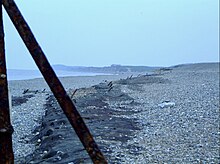Admiralty scaffolding




Admiralty scaffolding, also known as Obstacle Z.1 or sometimes simply given as beach scaffolding[1] or anti-tank scaffolding,[2] was a British design of anti-tank and anti-boat obstacle made of tubular steel. It was widely deployed on beaches of southern England, eastern England and South West England during the invasion crisis of 1940-1941.[3][4] Scaffolding was also used, though more sparingly, inland.[5]
Design and use
Of a number of similar designs, by far the most common was designated obstacle Z.1. This design comprised upright tubes 9 feet (2.7 m) high and 4 feet 10 inches (1.5 m) apart, these were connected by up to four horizontal tubes. Each upright was braced by a pair of diagonal tubes, at about 45°, to the rear.[6] 20-foot (6 m) wide sections were assembled then carried to the sea to be placed in position at the half tide mark as an obstacle to boats.[6]
However, trials found that a 250-ton barge at 5+1⁄2 knots (6.3 mph; 10.2 km/h) or an 80-ton trawler at 7+1⁄2 knots (8.6 mph; 13.9 km/h) would pass through the obstacle as if it were not there and a trawler easily pulled out one bay with an attached wire rope.[7] Tests in October 1940 confirmed that tanks could only break through with difficulty, as a result Z.1 was adopted as an anti-tank barrier for beaches thought suitable for landing tanks. As an anti-tank barrier it was placed at or just above the high water point[6] where it would be difficult for tanks to get enough momentum to break through the barrier. In some places, two sets of scaffolding were set up, one in the water against boats and one at high water against tanks.[8]
The problem of securing the barriers on sand was overcome by the development of the "sword picket" by Stewarts & Lloyds – this device was later known at the Admiralty as the "Wallace Sword".[7][9]
Barriers varying in length from a couple of hundred feet to three miles were constructed consuming 50% of Britain's production of scaffolding steel[6] at an estimated cost of £6,600 per mile[6] (equivalent to £460,000 today[10]). Despite this, many miles of Admiralty scaffolding were erected using more than 15,000 miles (24,000 km) of scaffolding tube.[9]
After the war, the scaffolding got in the way of swimmers,[11][12] subsequently it was removed for scrap and remaining traces are very rare, but occasionally revealed by storms.[13][14][15][16][17]
See also
References
Notes
- ^ "Beach Scaffolding". Online Thesaurus. English Heritage. Archived from the original on 18 July 2011. Retrieved 16 September 2010.
- ^ "Anti-tank Scaffolding". Online Thesaurus. English Heritage. Archived from the original on 18 July 2011. Retrieved 16 September 2010.
- ^ "The threat of invasion – June-September 1940". Retrieved 2 August 2010.
- ^ "Fear of Invasion – Beach Defences". Historic Cornwall. Cornwall Council – Historic Environment Service. Retrieved 4 August 2010.
- ^ Foot 2006, p. 11.
- ^ a b c d e Beach Scaffolding Defence; Trial – WO 199/1618. The Catalogue, The National Archives
- ^ a b "Scaffolding". Anti Invasion Defences of Suffolk. Archived from the original on 11 March 2012. Retrieved 30 August 2010.
- ^ Foot 2006, pp. 130–137.
- ^ a b Wills 1985, p. 42.
- ^ UK Retail Price Index inflation figures are based on data from Clark, Gregory (2017). "The Annual RPI and Average Earnings for Britain, 1209 to Present (New Series)". MeasuringWorth. Retrieved 7 May 2024.
- ^ Ann Broad. "Beach Scaffolding Makes for Difficult Swimming on the Sussex Coast". Walberswick Coastal Defences of World War II. Retrieved 4 August 2010.
- ^ Removal of Bathing Ban at Bournemouth. British Pathe. 1944. Retrieved 16 October 2016.
- ^ "Beach scaffolding – Lunan bay, Angus". pillboxesuk.co.uk. Archived from the original on 17 July 2010. Retrieved 4 August 2010.
- ^ "Beach Scaffolding, Pig's Bay to Wakering Stairs, Shoeburyness/Gt Wakering". Unlocking Essex's Past. Essex County Council. Retrieved 5 August 2010.[permanent dead link]
- ^ "WW2 Coastal Defences Salthouse, Kelling & Weybourne North Norfolk". Archived from the original on 15 August 2010. Retrieved 24 August 2010.
- ^ "Wartime Beach Defences are Revealed at Tregantle Beach, South East Cornwall in 1987/88". Cyber Heritage. Retrieved 23 March 2012.
- ^ Ruddy 2003, p. 25.
General references
- Foot, William (2006). Beaches, fields, streets, and hills ... the anti-invasion landscapes of England, 1940. Council for British Archaeology. ISBN 1-902771-53-2.
- Ruddy, Austin (2003). British Anti-Invasion Defences 1940–1945. Official Handbook of the Pillbox Study Group. Historic Military Press. ISBN 1-901313-20-4.
- Wills, Henry (1985). Pillboxes: A Study of UK Defences. Leo Cooper. ISBN 0-436-57360-1.
Collections
- "The National Archives". Repository of UK government records. Archived from the original on 17 February 2007. Retrieved 19 February 2007.
Further reading
- Mark Harrison. "Forgotten Frontline" (PDF). Archived from the original (PDF) on 23 July 2011. Retrieved 27 September 2010.
